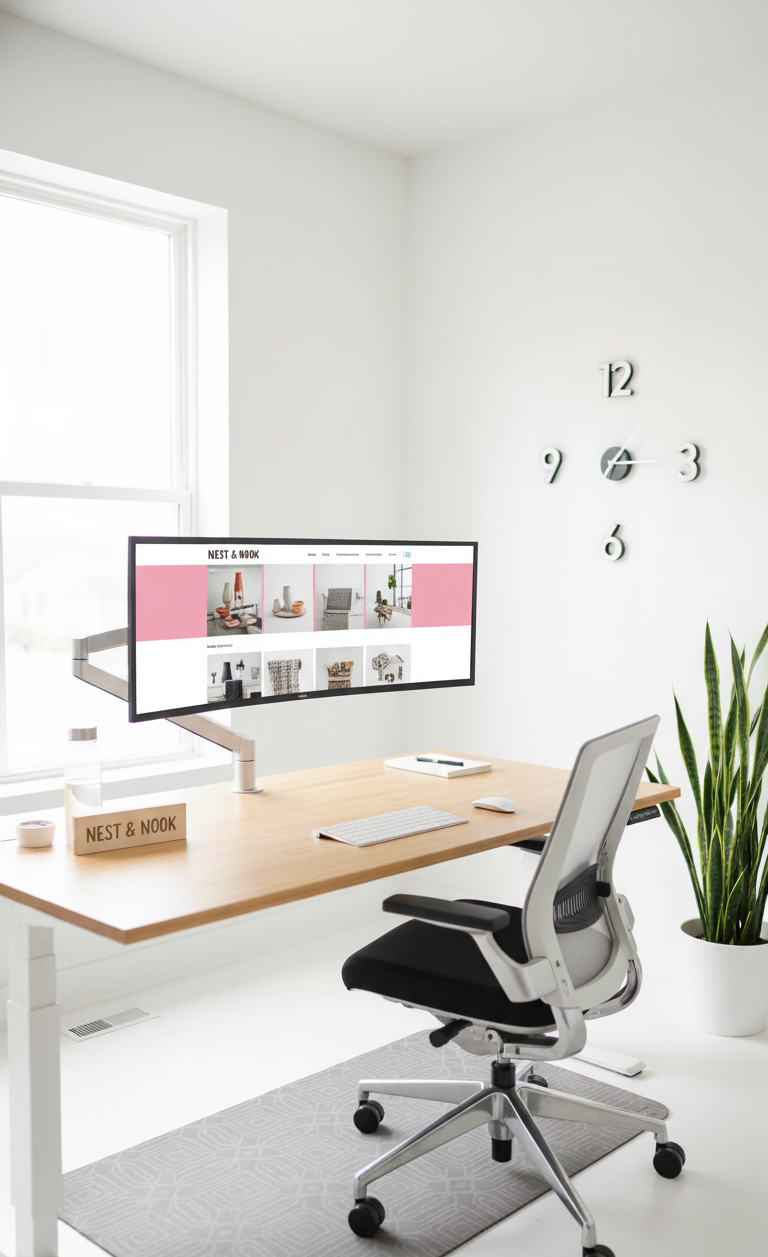The Active Workspace: A Comprehensive Guide to Standing Office Design
Exploring the minimalist, ergonomic approach to creating a healthier, more dynamic work environment
Introduction
In today's increasingly sedentary work culture, the concept of a standing office represents a revolutionary approach to workplace design. This article explores the innovative standing office concept—a workspace designed entirely for standing that promotes movement, health, and productivity. By eliminating the traditional chair and incorporating ergonomic elements, this design philosophy transforms how we interact with our work environment.

A modern minimalist standing office featuring a height-adjustable desk, ergonomic setup, and clean design elements
Visual Description & Design Elements
The standing office design embodies a minimalist and ergonomic aesthetic that prioritizes functionality and health. The core visual elements include:
Height-Adjustable Bamboo Desk
A large, spacious desk made of sustainable bamboo that can be adjusted to different heights to accommodate various user preferences and tasks.
Anti-Fatigue Mat
A comfortable mat designed to reduce strain on feet, legs, and back during extended periods of standing.
Adjustable Monitor Arm
A flexible arm that positions the screen at optimal eye level to prevent neck strain and promote good posture.
Bright, Energizing Lighting
Well-placed lighting that creates an energizing atmosphere and reduces eye strain during work sessions.
Natural Elements
A single healthy plant in the corner that adds visual interest and improves air quality.
Minimalist Color Scheme
White walls and clean lines that create a sense of spaciousness and reduce visual distractions.
How the Standing Office Works
The standing office operates on a simple yet powerful principle: encouraging movement throughout the workday. By eliminating the chair, the design naturally promotes a more active work style. The height-adjustable desk allows users to alternate between different positions, shifting weight between legs, stretching, and moving more freely.
Encourages Movement
Eliminating the chair naturally promotes more physical activity, weight shifting, and subtle movements
Enhanced Focus
Minimalist design reduces visual distractions while bright lighting maintains alertness
The ergonomic elements work together to create a workspace that supports the body's natural movements. The anti-fatigue mat reduces pressure on joints, while the monitor arm ensures proper screen positioning to maintain good posture. The bright lighting and natural elements help maintain energy levels and focus throughout the day.
Technologies & Applications
Key Technologies
Height-Adjustable Systems
Electric motors with programmable settings or manual counterbalance mechanisms
Ergonomic Accessories
Monitor arms, keyboard trays, and anti-fatigue mats designed for standing work
Lighting Technology
LED systems with adjustable color temperature to maintain energy and focus
Activity Tracking
Wearable devices and desk sensors that monitor movement and standing time
Practical Applications
Home Offices
Creates dedicated workspace for remote workers, separating work from living areas
Corporate Environments
Forward-thinking companies use standing desks to boost productivity and employee health
Creative Spaces
Designers and artists benefit from freedom of movement during creative processes
Healthcare Settings
Standing workstations enable quick mobility and better access to patients
Tips & Improvements
Optimizing Your Standing Office Experience
- Start gradually by alternating between sitting and standing, increasing standing time over several weeks.
- Wear supportive, comfortable shoes designed for extended standing.
- Position your monitor at eye level, about an arm's length away, to maintain good posture.
- Keep frequently used items within easy reach to avoid excessive stretching or bending.
- Incorporate movement breaks every 30-60 minutes to stretch and change positions.
- Consider adding a balance board or footrest to encourage subtle movements while standing.
- Ensure your desk height allows your elbows to be at a 90-degree angle when typing.
- Personalize your space with meaningful items that inspire and motivate you.
Conclusion
The standing office represents more than just a furniture arrangement—it's a philosophy that prioritizes health, movement, and productivity. By embracing this minimalist, ergonomic approach, we can transform our relationship with work, creating environments that energize rather than exhaust us.
As we continue to understand the health implications of prolonged sitting, standing offices offer a compelling solution that aligns with our body's natural need for movement. Whether you're designing a home office or reimagining a corporate workspace, the principles of the standing office can help create a more dynamic, health-conscious work environment.
The future of work is active, and the standing office is leading the way toward a healthier, more engaging approach to how we work.

No comments: